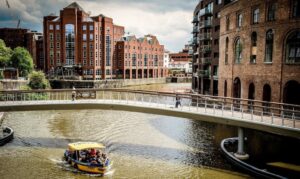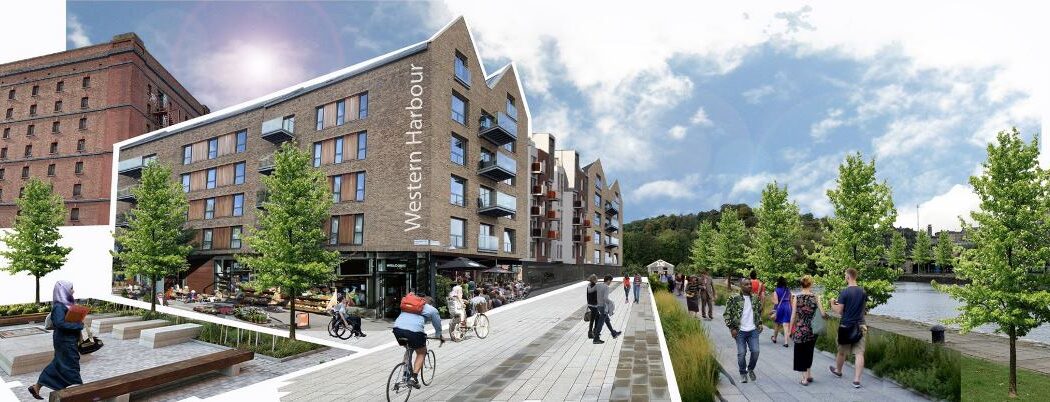While Britain’s Prime Minister, Boris Johnson was detailing his strategy for boosting economic recovery from the country’s trio of crises—COVID-19, Brexit and climate—recently, the National Trust, the Mayor of the West Midlands, Sustrans, Create Streets and local council leaders wrote to him urging a £5.5 billion commitment to an urban green infrastructure fund to leverage access to urban green space as part of his so-called “infrastructure revolution.”
The huge surge in people’s use of parks and green spaces during the coronavirus pandemic—up 25% May, compared to May 2018 and nearly doubling over the last decade from 1.2 billion visits in 2009-10 to 2.1 billion in 2018-19—and the significant inequality of provision exposed by the crisis, shows a need for urgent investment in greening neighborhoods, towns and cities.

Photo of Bristol, England’s harbor today by David Harper from Pixabay.
Research by Vivid Economics and Barton Wilmore, commissioned by the National Trust and partners, makes a powerful economic case for such a significant investment across the UK in greening the country’s most left behind and greyest urban communities over the next five years.
Greening neighborhoods, towns and cities brings a host of wider benefits to people’s lives, improving air quality, reducing summer temperatures and surface flooding, and making cycling and walking even more attractive.
It will also help make cities and towns resilient to climate change and achieve net zero ambitions, with this scale of investment delivering one in 12 of the UK’s tree planting target. Research on London’s green spaces showed for every £1 Councils spent on looking after parks, £27 in value was generated for people: a dramatic 27:1 return on investment (ROI).
This green infrastructure investment would bring an impressive £200 billion in physical health benefits through disease prevention and mental wellbeing benefits to alleviate some of the strain on local health service providers and to improve people’s quality of life.
Over 20 million people would feel the benefit from this investment, nearly a third of the UK population. Local economies would also benefit from job creation, particularly in those areas of the country facing high levels of unemployment, with an estimated 40,000 jobs in initial construction and over 6,000 created permanently for ongoing maintenance.
The research mapped the most deprived and greyest areas of Great Britain and assessed the costs and benefits of three major interventions to leverage access to quality green spaces:
- Greening urban streets and neighborhoods, creating street parks and connecting-up local green spaces to enable safe and attractive walking and cycling for everyone, whether that’s to school, work, for leisure or shopping on the high street.
- Upgrading poor quality parks and green spaces so they are fit for the 21st Century, with more trees and wildlife, cycling routes, and with facilities for communities to significantly boost recreation, play and sport.
- Creating large regional parks and forests in the urban fringe, on green belt land, connected into the city, to give millions of people the freedom to explore and play in wild natural spaces, without needing a car.
Andy Street, the Mayor of West Midlands said “We are immensely proud of our green spaces here in the West Midlands, and we have fought tremendously hard to keep them – particularly when it comes to housebuilders eyeing up our greenbelt land. The coronavirus pandemic has shown us just how important these spaces are, not just for physical well-being but also for people’s mental health as well. Because of this there is now real potential to achieve bold, green, change in the next few years, and this must be at the forefront of the Government’s mind as it begins to draw up recovery plans for the country.”
“Here in the West Midlands, we have big ambitions for a new kind of National Park to unite the people of the West Midlands with their landscape and shared heritage. We want to connect our dense grey areas with surrounding green acres, create new urban greenspace, cycle routes, and wildlife-rich areas across all our towns and cities,” he added. “Whether it is getting more people moving to tackle high-levels of obesity, or planting more trees to help us reach our climate change targets, an urban national park is an innovative idea that would make a significant difference to our region.”
Covid19 has exposed deep inequalities in access to green space:
- 295 deprived neighborhoods of 440,000 people that are grey deserts, with no trees or accessible green space.
- In areas where over 40 per cent of residents are from ethnic minorities, there is 11 times less public green space than in areas where residents are largely white, and it is also likely to be of poorer quality. Meanwhile, black people are four times less likely than white people to have a private garden.
- Black and Asian people visit natural settings 60 per cent less than white people, despite the fact that ethnic minority communities statistically value parks more than their white counterparts.
- In the poorest 20 per cent of households, 46 per cent don’t have a car, so urban parks and green spaces are their only opportunity to have contact with nature, rural beauty spots are beyond reach.
Marvin Rees, Mayor of Bristol, said “We know how vital parks and urban green spaces have always been to the health and wellbeing of Bristol communities, and especially during the pandemic. The use of them has shot up as they have become part of the people’s daily routine for walks and family bike rides, the neighbourhood gym, a place for socialising once lockdown restrictions eased and a therapeutic escape for us all.”
“Whilst Bristol prides itself as a green city, not everyone can see a tree from their window, not all of us have easy access to brilliant parks, not every child can experience the joy of the natural world,” he continued. “We are changing that inequality through our city’s recovery plan. It will put green and liveable neighbourhoods at the centre, empowering our communities to bring trees, nature and aspiration into their streets and shared spaces.”
“We have exciting plans to create new city centre parks and turn some of our car parks into new beautiful green spaces, like in Paris. We also have ambitious plans to transform and connect the city’s network of green spaces, working with business and community partners. But we need investment to unlock this potential and kick start our green recovery,” Rees concluded.
Examples of the sort of projects, from micro to macro, that could be created by this scale of investment across the country include:
- Turning an under-used side road into a local street park and ‘edible walkway’ such as that planned for Freeling Street in Islington, North London, led by the community.
- New green boulevards and public squares to bring people back to high streets and city centres, as proposed for the Millbay area of Plymouth[15].
- Green, traffic-free routes from Manchester city centre to out to wilder countryside sites via Borough towns.
- A new regional park for the West Midlands covering more than seven towns and cities, and creating hundreds of miles of green space, conservation areas and new cycle routes.
Easy access to quality green space has become an essential need for urban dwellers. Nearly two-thirds of people have appreciated local greenspaces more due to Covid-19 and that they want them to be a higher priority for government priority. Some inner-city parks have experienced a close to 300 per cent increase in visits this spring. The National Trust has also experienced unprecedented visitor numbers to its urban fringe sites.
The National Trust and the other signatories have offered to assist government in delivering at pace green infrastructure improvements for those urban communities in greatest need, using their collective powers and abilities.
Hilary McGrady, Director-General of the National Trust said “We are calling for a major collaborative effort – for national government, local councils, charities, businesses, communities and funders across our cities and towns to work together in new ways to bring nature and beautiful green spaces into everyone’s lives. Everyone needs access to natural beauty for their wellbeing. It’s the very foundations on which the Trust was built, and we want to live up to that ambition by supporting partners, projects and innovations that can deliver this humble but inspiring benefit to millions more people.”
“Now is the time for Government to be bold and ambitious for the future, investing in the upgrade, extension and connection of the vital green infrastructure of towns and cities, just as it is doing for transport infrastructure. The Prime Minister could lead a transformation that enables all urban dwellers to live with beauty; a gift of renewal and hope comparable to the post-war creation of the nation’s great rural National Parks and its urban green belts,” she added.
Featured rendering of a green and revitalized Western Harbour in Bristol courtesy of City of Bristol.

